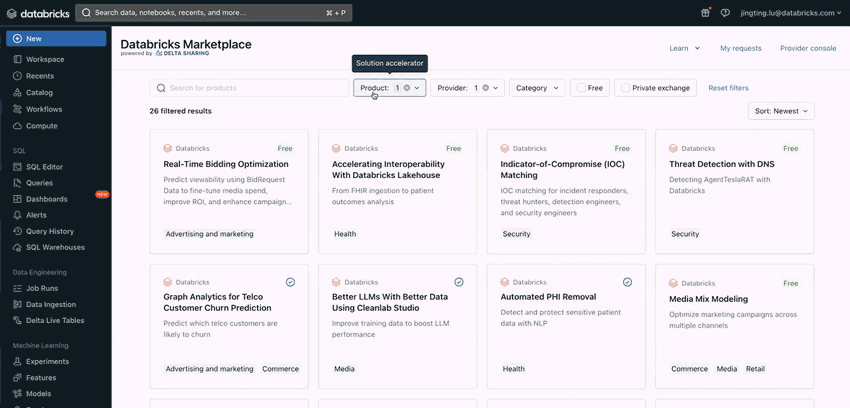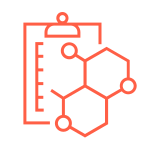Accelerate Your AI Journey with Pre-built Industry Solutions on Databricks Marketplace

Every organization is seeking to gain value from data—whether internally or externally from third-party data acquired from data marketplaces. Organizations across industries can benefit from secure data sharing and collaboration to generate new insights and unlock innovation — across a variety of industry imperatives from customer personalization to patient healthcare experience to supply chain and manufacturing optimization to risk management.
Collaboration on the Databricks Lakehouse Platform is powered by Delta Sharing, the first open source approach to data sharing across data, analytics, and AI. We recently announced the general availability of Delta Sharing and the general availability of Databricks Marketplace built on Delta Sharing. Databricks Marketplace is an open marketplace that enables you to share and exchange data assets, including datasets and notebooks. Our open marketplace brings together a vast ecosystem of data consumers and data providers, enabling collaboration with a wide array of data and AI products, across clouds, regions, and platforms. Since launching in June, Databricks Marketplace has 500+ offerings from 80+ providers, enabling customers to discover more than just data, evaluate products faster, and unlock innovation to advance their organization's data and AI initiatives.
Today, we are excited to announce Databricks Marketplace is including industry-specific Solution Accelerators — available for free and instantly accessible. Adding to the data assets already offered on Marketplace, these solution accelerators provide pre-built code, sample data, and other time-saving tools tailored for specific industries including Financial Services, Healthcare & Life Sciences, Communications, Media & Entertainment, Retail and Consumer Goods, & Manufacturing.

Innovate Faster with Databricks Solution Accelerators
Moving at the speed of business requires organizations to maximize the value extracted from data at an increased pace. Data sharing and collaboration help organizations lessen time-to-insights without reinventing the wheel by benefitting from best practices and data-driven recommendations.
With solution accelerators, users can save hours of discovery, design, development and testing — going from ideation to a proof of concept in as fast as two weeks.
Databricks Solution Accelerators are fully-functional solutions based on best practices that help organizations drive rapid results across common, mission-critical industry use cases. These solution accelerators include step-by-step instructions that provide business context on how to get started, along with pre-built notebooks and other technical assets that further explain implementation and usage. With solution accelerators, users can save hours of discovery, design, development and testing — going from ideation to a proof of concept in as fast as two weeks.
As part of the mission to democratize data and AI for enterprises worldwide, Databricks has curated this initial set of solution accelerators for data practitioners on the Marketplace. In addition to Databricks-driven development, an open community of ISV and SI partners contribute to the solution accelerator codebase – combining their domain depth with the advantages of the Databricks Lakehouse Platform to integrate data and AI into business processes.
Learn more about the Solution Accelerators on Databricks Marketplace below, so you can get started using them in your own Databricks workspaces:

Communications, Media and Entertainment
Communications, media, and entertainment (CME) companies want to extract the full value of their unstructured data (e.g. video, images, audio, etc) to personalize the audience experience, optimize advertising and marketing spend, and generate new monetization opportunities.
Here are some key solution accelerators for organizations on that journey:
- Improving LLMs with Cleanlab Studio: Erroneous data hampers the training and evaluation of large language models (LLM) across tasks like intent recognition, entity recognition and sequence generation. Real-world data sets have been found to contain 7%–50% annotation errors. Our joint Solution Accelerator with Cleanlab Studio demonstrates how Data-centric AI (DCAI) can improve the performance of training data to boost LLM performance by 37% without changing the model architecture, hyperparameters or the training process.
- Optimizing Real-Time Bidding (RTB): RTB is a subcategory of programmatic media buying. The value of RTB is that it creates greater transparency for both publishers (better control inventory and unit costs) and advertisers (can boost advertising effectiveness by only bidding on impressions that are likely to be viewed. By building a reliable, scalable, and efficient pipeline to predict viewability, advertisers can more accurately identify where to spend their marketing budgets to fine-tune media spend, improve ROI, and enhance campaign effectiveness.
- Media Mix Modeling (MMM): MMM is a data-driven methodology that enables companies to identify and measure the impact of their marketing campaigns across multiple channels. MMM helps businesses make better-informed decisions about their advertising and marketing strategies. Specifically, you can unify data from various channels, measure marketing effectiveness in driving engagement and revenue, simulate channel scenarios to improve campaign performance, and optimize media spend allocations.
- Graph Analytics for Telecommunications Customer Churn Prediction: Graph analytics can provide valuable insights into customer behavior and interactions, enabling more accurate churn prediction and proactive retention strategies by leveraging the inherent relationships and connections in the network. You can analyze call network graphs at scale, create models for predicting customer churn, and see how telecommunications companies can take proactive steps to retain customers and improve the overall customer experience.
Learn more about the Lakehouse for Communications, Media and Entertainment
Explore the Marketplace for Media and Entertainment
Browse Marketplace listings
Explore the Marketplace for Advertising and Marketing
Browse Marketplace listings

Healthcare and Life Sciences
Healthcare and Life Sciences (HLS) organizations seek to converge their research, operational, and patient data with powerful analytics and AI capabilities. Doing so enables HLS organizations to offer better patient experiences with better outcomes, at the lowest cost, with the greatest investment protection.
Today, solution accelerators are helping these organizations accelerate time-to-value from their data across core use cases. For example, Providence Health worked with Databricks and John Snow Labs to build a de-identification pipeline for 700 million patient records using pre-trained deep learning models. Specifically, they de-identifed hundreds of millions of records of historical data and incremental daily loads of clinical electronic medical record (EMR) data, and automated removal of Protected Health Information (PHI) to support medical research and the development of novel treatments. (Watch DAIS 2022 session with Providence Health).
Here are some solution accelerators which curate and analyze data to help HLS use cases across research and development, clinical development, and patient analytics:
- FHIR Interoperability with dbignite: Healthcare runs on interoperable standards, from point-to-point HL7 interfaces to APIs, such as Fast Healthcare Inteorperable Resources (FHIR). With this solution accelerator, organizations can take advantage of the Databricks Lakehouse Platform to analyze patient outcomes using EHR data. The solution helps extract FHIR resources such as patients, encounters, and conditions to create a dataset ready for exploratory data analysis.
- Automated PHI Removal: Collaborating on clinical research across organizations may require de-identifying PHI and highly sensitive data elements (e.g., first name, last name, date of birth, etc.) governed by The Health Insurance Portability and Accountability Act of 1996 (HIPAA). Our joint Solution Accelerator with John Snow Labs automates the detection of sensitive PHI contained within unstructured data, such as images and PDFs, using Natural Language Processing (NLP) models for Healthcare. Once extracted, data is stored within the Lakehouse, where teams can use pre-trained models to easily remove, obfuscate, or mask data for downstream collaboration and analytics at scale.
- Digital Pathology Image Analysis: Tumor proliferation speed or growth is an important biomarker for predicting patient outcomes. In this solution accelerator, we provide a step-by-step guide on using the Databricks Lakehouse Platform to perform image segmentation and pre-processing on a whole slide image (WSI), as well as how to train a binary classifier that produces a metastasis probability map over a WSI.
Learn more about the Lakehouse for Healthcare and Life Sciences
Explore the Marketplace for Healthcare and Life Sciences
Browse Marketplace listings

Cybersecurity
Modern cybersecurity teams have to adapt and expand their scope to defend both on-premises and multi-cloud footprints. However, the cost and complexity of using siloed tools together can be challenging for a unified and effective threat detection and response.
Here are some techniques we've codified as solution accelerators for cybersecurity teams:
- IOC Matching: Cybersecurity in multicloud, multi-region environments presents challenges with fragmented security controls, data dispersion and compliance. This solution accelerator shows how the Lakehouse can centralize security management by running an Indicators of Compromise (IOC) detection rule against data stored in multiple clouds and regions. This enables customers to limit egress costs, deploy uniform access controls, execute distributed security searches and facilitate consistent governance practices.
- Threat Detection with DNS: This accelerator will allow you to use Delta, Spark and MLflow to build an ML model against DNS traffic logs, enriching streaming threat intelligence and applying advanced analytics to detect DNS abnormalities and prevent malicious attacks. Performing DNS analytics at a petabyte scale will accelerate the time to detection and response and prevent malicious attacks.
- Incident Investigation using Graphistry: In this solution accelerator, we showcase how SOC analysts, Incident Responders and Threat Hunters can use graph analytics on Databricks to investigate an incident or alert, determine the host and users impacted, and identify remediation steps. The analysts can investigate leads from a threat-hunting exercise or hunt for threats given a piece of threat intelligence or a news release.
Learn more about the Security on the Lakehouse
Explore the Marketplace for Security
Browse Marketplace listings
Security and Trust Center - Databricks Lakehouse Platform
Be sure to check out any of the solution accelerators detailed above in the Marketplace and install them for free within your Databricks workspace.
Watch this demo and learn how to get started with a solution accelerator on Databricks Marketplace:
Getting Started with Solutions Accelerators on Databricks Marketplace
- Watch demo on Databricks Marketplace to learn how to get started.
- Watch session on Databricks Marketplace from DAIS 2023: Going beyond data and applications.
- Dive deeper into the Databricks Marketplace documentation.
- Watch data sharing webinar with industry leaders on strategies and best practices for successful data sharing.
- Download eBook, A New Approach to Data Sharing - Second Edition.

